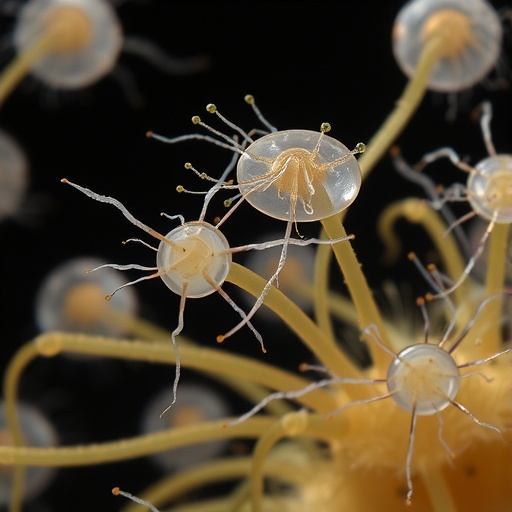In a groundbreaking advancement that could redefine our approach to combating bacterial infections, researchers have unveiled the formidable therapeutic potential of a bacteriophage, specifically Shigella phage SSG23, targeting biofilms formed by Shigella sonnei. This discovery opens new horizons in the fight against antibiotic-resistant infections by exploiting the natural predators of bacteria—viruses known as bacteriophages—with precision and efficacy. The study, conducted on both in vitro biofilms and in vivo using BALB/c mice, sheds light on an innovative biological strategy that could transform treatment paradigms for one of the most challenging enteric pathogens.
Shigella sonnei, a bacterium responsible for shigellosis, represents a significant public health concern globally. It causes dysenteric diarrhea and poses a particular challenge due to increasing antibiotic resistance and the bacterium’s ability to form biofilms, which confer protection against conventional therapeutics. These biofilms create a fortified matrix allowing bacterial communities to persist in hostile environments, making infections recalcitrant to treatment and facilitating chronic disease states. This new research targets the biofilm stage of S. sonnei, showcasing how bacteriophage therapy might overcome this intrinsic bacterial defense mechanism.
Bacteriophages, or simply phages, are viruses that specifically infect bacteria, hijacking their machinery to replicate and subsequently cause bacterial cell lysis. The particular phage SSG23, studied here, demonstrates a highly specific lytic cycle against Shigella sonnei, disrupting biofilm architecture and reducing bacterial viability. Unlike conventional antibiotics, phages can evolve alongside their bacterial targets, reducing the likelihood of resistance development. Moreover, phages can penetrate biofilms, a feat extremely challenging for small-molecule drugs due to the dense extracellular polymeric substances in biofilm matrices.
The research team employed rigorous methodologies to evaluate the lytic efficiency of phage SSG23. Initial tests involved establishing robust S. sonnei biofilms under controlled laboratory conditions, followed by treatment with phage preparations. Quantitative metrics indicated significant reductions in biofilm biomass and viable bacterial counts post-treatment. This included microscopic imaging that confirmed structural biofilm degradation and dispersal of bacterial clusters, elucidating the phage’s biofilm-targeting capability.
Crucially, the investigation extended to an in vivo model, employing BALB/c mice, which provided insights into the phage’s therapeutic potential in a mammalian host. The murine infection model accurately recapitulated human-like Shigella infection dynamics, allowing evaluation of safety, efficacy, and immunological responses. Treatment with SSG23 not only diminished bacterial loads in the intestinal tissues but also alleviated infection-associated morbidity, suggesting the phage’s utility as a viable antimicrobial agent with minimal side effects.
While phage therapy is not a novel concept, its resurgence and renewed validation in the era of escalating antibiotic resistance is remarkable. The specificity of phages limits collateral damage to beneficial microbiota, unlike broad-spectrum antibiotics that disrupt host microbial communities and may promote secondary infections. Moreover, the natural abundance and diversity of bacteriophages provide a vast reservoir for developing targeted therapeutics against a multitude of bacterial pathogens, including multidrug-resistant strains.
A significant aspect of this study is its focus on biofilms, complicating infections in both clinical and environmental contexts. Biofilms act as reservoirs for persistent infection and facilitate horizontal gene transfer among bacteria, further spreading resistance genes. The ability of phage SSG23 to degrade these biofilms highlights a dual therapeutic effect: direct bacterial killing and dismantling of the protective environment that shelters resistant bacterial populations.
The safety profile of bacteriophage therapy remains paramount, particularly when transitioning from bench to bedside. This study’s use of immunocompetent mice afforded critical data on immune responses to phage administration. Encouragingly, no significant adverse effects or overt immune activation were observed, underpinning the biocompatibility of this therapeutic agent. The phage persisted in the gastrointestinal tract long enough to exert antibacterial effects but without inducing detrimental systemic immune responses.
Mechanistically, the study delves into the interaction between phage SSG23 and the bacterial biofilm matrix. Phages encode depolymerases—enzymes capable of degrading polysaccharides within the biofilm matrix. These enzymatic functions are pivotal for phage penetration and subsequent bacterial infection. SSG23’s ability to produce such enzymes enhances its efficacy, enabling it to breach biofilm defenses and access individual bacterial cells embedded within.
This research also considers the implications of phage therapy within a clinical context. The authors underscore the need for carefully formulated dosage regimens, ensuring optimal phage titers reach infection sites without eliciting phage-neutralizing antibodies too early. The repeated dosing strategies explored reveal a balance between maximizing phage impact and minimizing immune-mediated clearance, a critical consideration for therapeutic success.
Integrating phage therapy with existing antibiotic protocols could potentiate antimicrobial regimens, leveraging synergistic interactions. For instance, biofilm disruption by phage enzymes might render bacteria more susceptible to antibiotics, enabling lower antibiotic dosages and mitigating resistance pressures. This combinational approach affirms the role of phage therapy not just as a standalone treatment but as a complementary tool in the antimicrobial arsenal.
Looking ahead, the translation of these findings into human clinical trials mandates meticulous standardization of phage production, purification, and storage to ensure safety and efficacy. Regulatory frameworks must evolve to accommodate these viral therapeutics, given their unique biological nature compared to traditional small-molecule drugs. Nonetheless, the precision targeting and adaptability of phage therapy signify a paradigm shift in infectious disease treatment, especially for stubborn biofilm-mediated infections.
The potential of phage SSG23 as a targeted antimicrobial agent offers a beacon of hope amid the escalating global crisis of antibiotic resistance. By exploiting the natural evolutionary arms race between bacteria and their viral predators, this strategy embodies a sophisticated, eco-friendly, and potentially game-changing approach. The successful attenuation of Shigella sonnei biofilms and infection burden in preclinical models marks a pivotal milestone, encouraging further development and clinical exploration.
The study’s broader implications extend beyond Shigella infections, touching upon other biofilm-associated pathogens responsible for chronic infections in diverse medical contexts, including device-associated infections, chronic wounds, and respiratory diseases. Tailoring phages to target such pathogens could revolutionize treatment strategies across a spectrum of persistent bacterial infections difficult to manage with contemporary antibiotics.
In conclusion, the demonstrated therapeutic efficacy of Shigella phage SSG23 represents a substantial advance in the field of phage therapy and infectious disease management. The dual action against biofilms and bacterial populations, coupled with safety in mammalian models, sets the foundation for future translational research aiming to validate phage therapy within clinical frameworks. As antibiotic resistance escalates globally, innovations such as these are critical to preserving and advancing human health.
Subject of Research: Therapeutic potential of bacteriophage SSG23 against Shigella sonnei biofilms and infection.
Article Title: Therapeutic potential of Shigella phage SSG23 against Shigella sonnei biofilms and in BALB/c mice.
Article References:
Mondal, P., Das, S., Ramesh, A. et al. Therapeutic potential of Shigella phage SSG23 against Shigella sonnei biofilms and in BALB/c mice. npj Viruses 3, 73 (2025). https://doi.org/10.1038/s44298-025-00155-4
Image Credits: AI Generated
Tags: antibiotic resistance solutionsbacteriophage effectivenessbacteriophage SSG23biofilm-associated infectionschronic disease managementdysentery treatment innovationsenteric pathogen researchin vivo biofilm studiesnovel antibacterial strategiespublic health bacterial threatsS. sonnei biofilm treatmentShigella phage therapy





